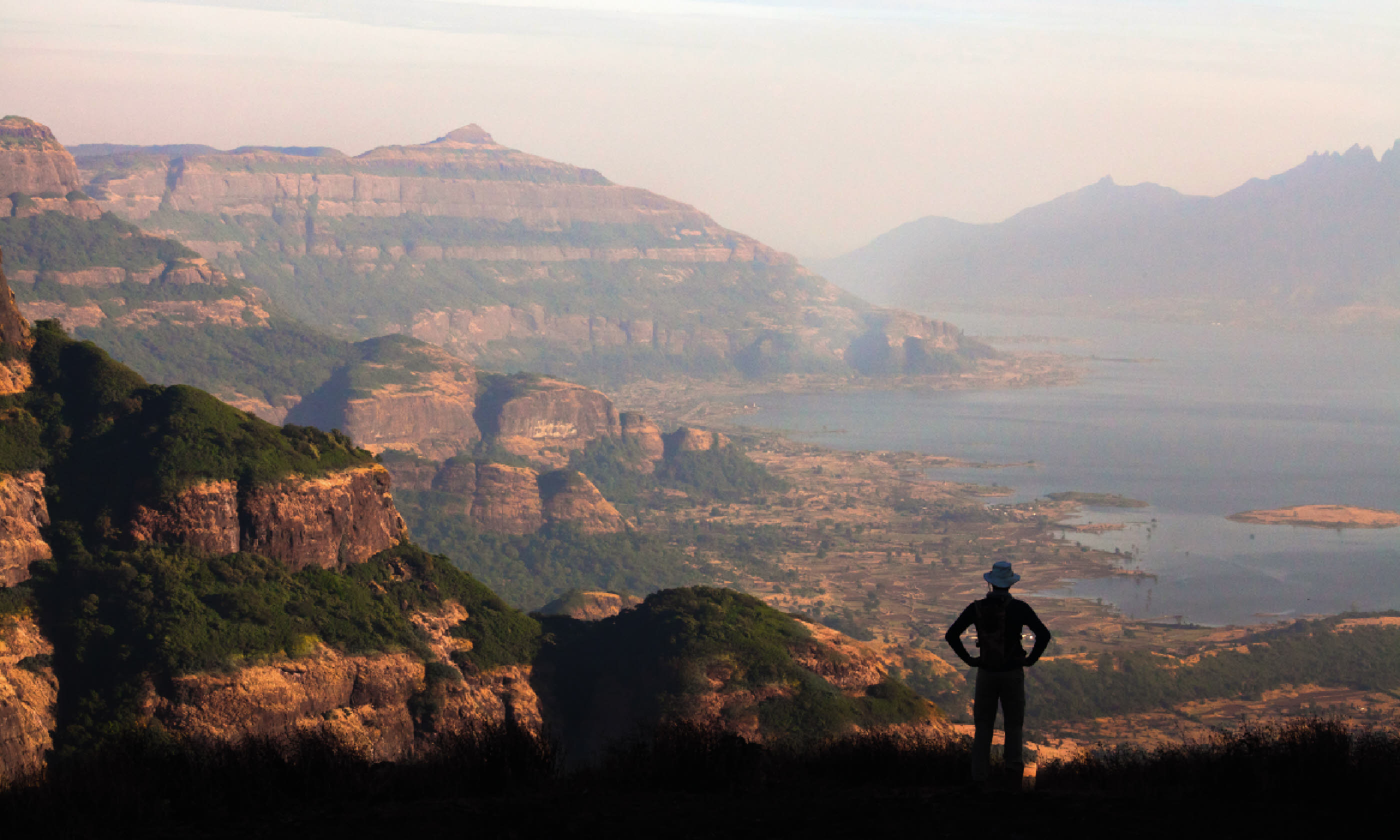
Sacred steps in India's Western Ghats
Mud-walled villages, temple ruins, hilltop forts, astounding landforms – although just outside Mumbai, the Western Ghats of northern Maharashtra couldn’t feel much further from Bollywood bling
It all started with a knock at the door and a bag of fruit. My neighbour, Pilot, who flies 747s to India a couple of times a month, had come to deliver a consignment of ripe Alphonso mangos, purchased the previous day in a Mumbai street market. They smelled of tropical sunshine and tasted sublime.
Between slurps of sticky mango juice around our kitchen table, the conversation turned to a passion the two of us share in common: travel in off-track parts of India. “Hey,” said Pilot “have you ever been to those mountains just outside Mumbai? Air traffic control had us flying figure-of-eights over them for ages last week and they look amazing.”
A quick search on GoogleMaps confirmed the mountains in question were the northern extremity of the Western Ghat range, which runs in parallel with India’s coastline all the way from Gujarat to the southernmost tip of the subcontinent at Kanyakumari. In the state of Maharashtra, they peak at 1,646m – not exactly Himalayan proportions, but a good notch higher than Ben Nevis. Further research revealed many of their summit ridges were littered with gravity-defying forts, ruined temples and rock-cut cave shrines linked by networks of ancient pilgrimage trails.
I couldn’t believe that despite having passed through them several times I’d never paid much attention to these enigmatic, yellowbrown giants, known locally as the Sahyadris. Six months later, in the wake of the monsoons, with traces of greenery still in the verges and cauliflower-topped clouds building inland, Pilot and I were on our way to remedy this neglect.
We’d met in Mumbai, and set off into the mayhem of city traffic in a hire car with our driver, Lakshman. It took a couple of hours to break out of the gridlock. After a century and a half of confinement to the land reclaimed by the British, the Maharashtran metropolis has finally burst across the plains to its east. Giant skyscrapers, shopping malls, overpasses and huge hoardings advertising gated residences with rooftop pools are springing up alongside the recently built eight-lane expressway.
India has entered a new age, though it’s one I’m always keen to leave behind as soon as possible when I visit. Which is why a broad grin spread across my face as we finally turned off the highway and started bumping along country lanes towards the dramatic wall of mountains up ahead.
Surging sheer from the plain, the Sahyadris form an imposing barrier between the Konkan Coast and higher, drier Deccan Plateau beyond them – a line of angular peaks standing shoulder-toshoulder like a cordon of giant, square-jawed sentries. After weeks of planning and a very long journey, the first target on our hit list – Prabalgad Fort – was finally in our sights.
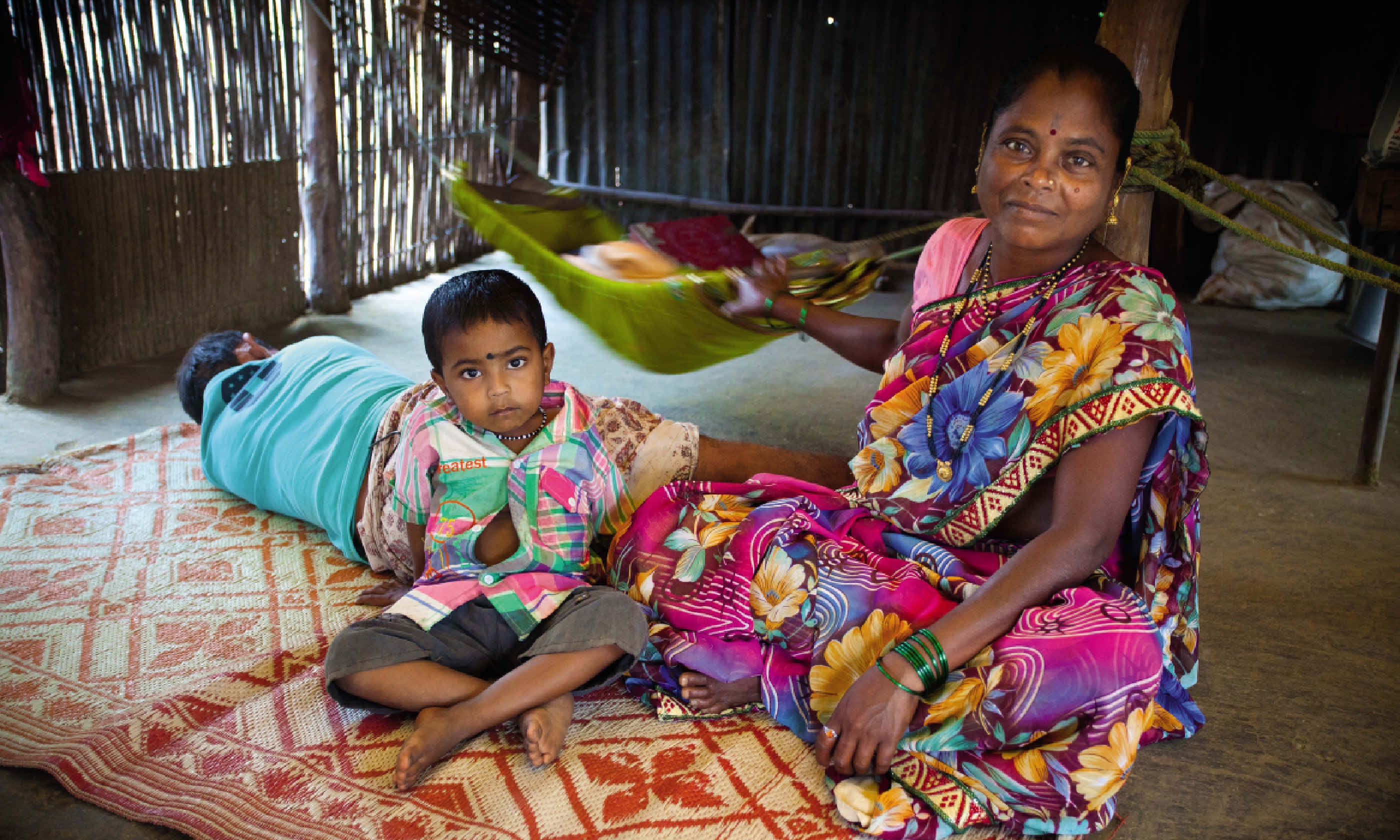 The Bhutambara family offer simple lodging in Prabalmachi
The Bhutambara family offer simple lodging in Prabalmachi
Prabalgad is an outlier of the main range. In centuries past it was used by the region’s ruling dynasties as a citadel from which to dominate the trade artery stretching across the plain beneath it. We’d chosen the mountain because of its distinctive form. Shaped like a giant rhinoceros, the massif has a weird, conical ‘horn’ on its north side – the Kalavantin Pinnacle – which used to serve as a lookout post. I’d come across photos of it online and had been intrigued by the ladder of steps snaking up its near-vertical side.
To climb the rock tower, however, we first had to get to the village clustered below its base, on what is known locally as a machi – a kind of mountain balcony of cultivable land 300-350m wide. At an elevation of 400m, machis are invisible from below, and tend to be overshadowed by huge cliffs that ensure a steady supply of water.
The resulting fecundity was much in evidence as we toiled through the heat of late afternoon to reach the rim of the hidden veranda. After the traffic of the expressway, arriving in Prabalmachi village felt like arriving in an Indian Eden. Fruit trees, banana groves and stately old banyans bordered dark-soiled fields grazed by herds of sleek cattle and goats. Colourful birds flitted between the branches overhead and bees were busy in the flowers. It was hard to believe the squalid fringes of Mumbai were only 14km away as the crow flies.
Most of the machi villages in the Sahyadris are inhabited by Adivasi communities – the so-called tribal or indigenous inhabitants of peninsula India. For centuries, the Adivasis seem to have been little affected by the political and cultural changes sweeping up and down the nearby road, collecting cliff honey, forest fruit and bush meat, and growing subsistence crops of millet and rice. Lately, however, their villages have been haemorrhaging young folk to the city.
One such migrant was the eldest son of our hosts for the night, the Bhutambara family. Nilesh Bhutambara had studied computer sciences at college – the first ever graduate from Prabalmachi – and found a salaried government job in distant Chennai (Madras). Realising from trekkers’ blogs that interest in Prabalgad Fort was building online, he created a little website to publicise the bunkhouse his family have set up to earn a few extra rupees – a great example of a low-impact, grass-roots tourism initiative.
With Nilesh acting as a translator on the mobile from the other side of the country, his brother-in-law, Kisan, showed us to a neatly painted little room decorated with pictures of Hindu gods and Bollywood stars. After a cooling bucket bath (the village lacks running water and only has an intermittent electricity supply), we settled down to a thali of wonderfully fragrant, spicy aubergines and rice infused with aromas of fresh curry leaves and wood smoke. Pilot bagged the room. I bedded down on my camping mat in the yard outside, under the starriest of skies, and fell asleep listening to a cacophony of frogs and cicadas.
They were still chirruping madly at 5am the following morning when I was awoken by Kisan carrying a tray of tea and kande pohe – a traditional Maharashtran breakfast made of beaten rice, freshly grated coconut, lime juice, green chillies and coriander leaf. Thus fortified, we stumbled through the inky darkness with Kisan leading the way, headtorch beams periodically illuminating the eyes of sleepy water buffalo as the path cut uphill through the forest.
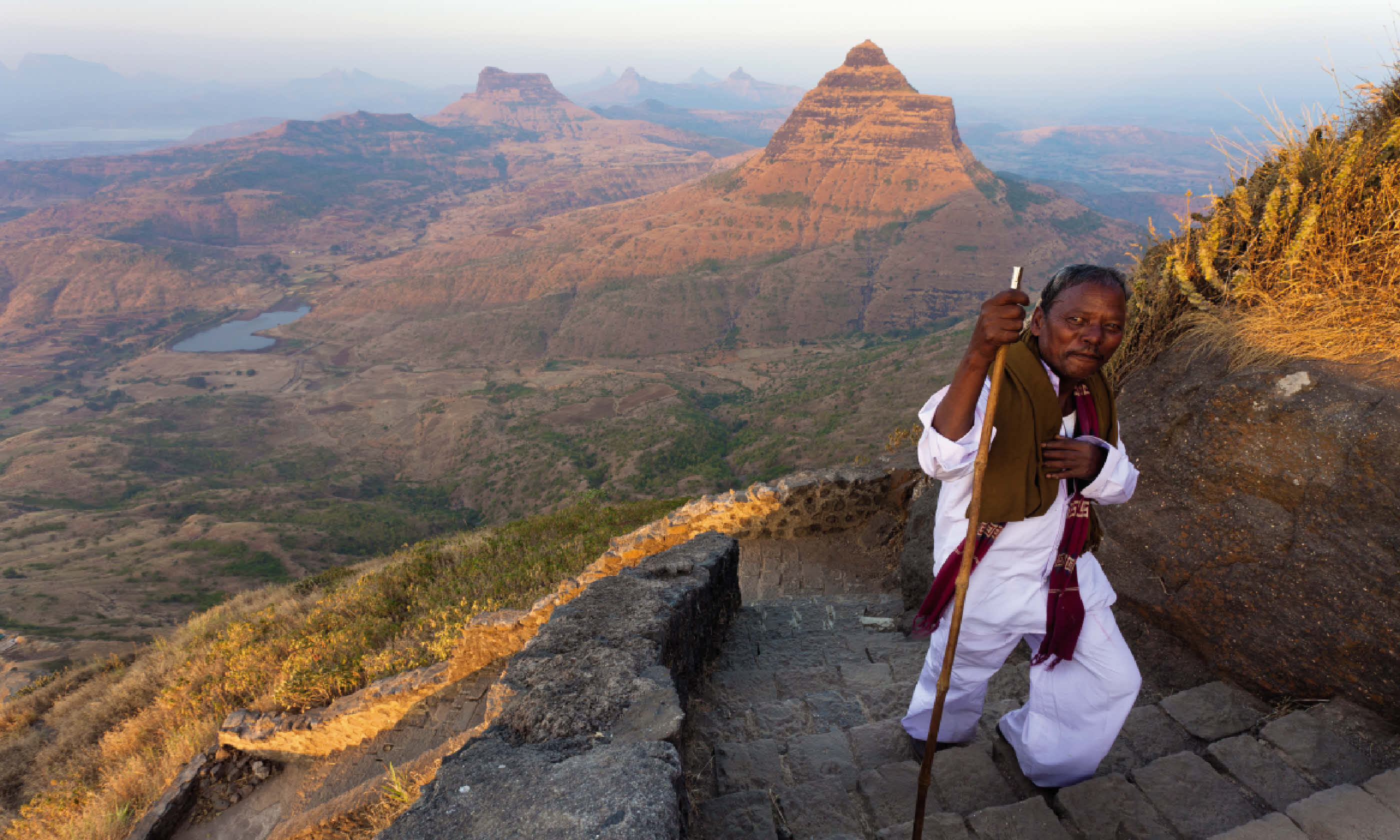 Climbing the sacred steps in the Sahyadris
Climbing the sacred steps in the Sahyadris
By the time we’d climbed clear of the trees and reached the summit ridge of the mountain, the first rays of daylight were illuminating the plains below, shrouded in river mist and smoke. A trio of red-headed merlins soared from the crags below us, where the tip of the Kalavantin Pinnacle glowed orange in the foreground, framed by a backdrop of table-topped peaks.
It took another hour of scrambling through boulders and undergrowth to reach the foot of the steps scraped from the sides of the pillar in medieval times. A troupe of black-faced langur monkeys eyed our progress suspiciously from the cliff above, sending up occasional whoops of alarm that echoed through the surrounding rocks. The climb turned out to be every bit as vertigo-inducing as it looked, but was rewarded with another stupendous view.
Gazing at the hulks of newly built tower blocks looming out of the smog on the horizon, I was struck by what a different kind of India we’d spent the past 12 hours in – a far cry from the fumes, dust and clamour most other travellers were waking up to. There wasn’t a speck of litter anywhere to be seen and the fresh morning air was filled with birdsong and the scent of forest herbs.
The next mountain on our itinerary was more remote still. Like Prabalgad, Bhimashankar doesn’t feature in any guidebooks, despite being the site of one of the country’s holiest Shiva shrines. A tarred road winds to it from the east. But the traditional approach is on foot, via a trail that twists through magnificent jungle and cliffs.
The huge escarpments buttressing Bhimashankar looked all the more intimidating in the gathering dusk. We’d been late setting off, and by the time we reached the machi halfway up we were walking in total darkness. Hundreds of tiny flecks of light sparkled on the forest floor. I thought they were fragments of mica, but they turned out to be spiders’ eyes reflecting the light of our torch beams.
Fat rain drops were falling when we finally arrived at the machi village – harbingers of one of the most violent, ear-splitting electrical storms I’ve ever witnessed. Spectacular flashes of fork lightning soon lit up the cliff. Then the rain started in earnest, cascading in torrents off the terracotta roof tiles. We certainly would not be making it to the hotel that we’d booked for the night outside Bhimashankar.
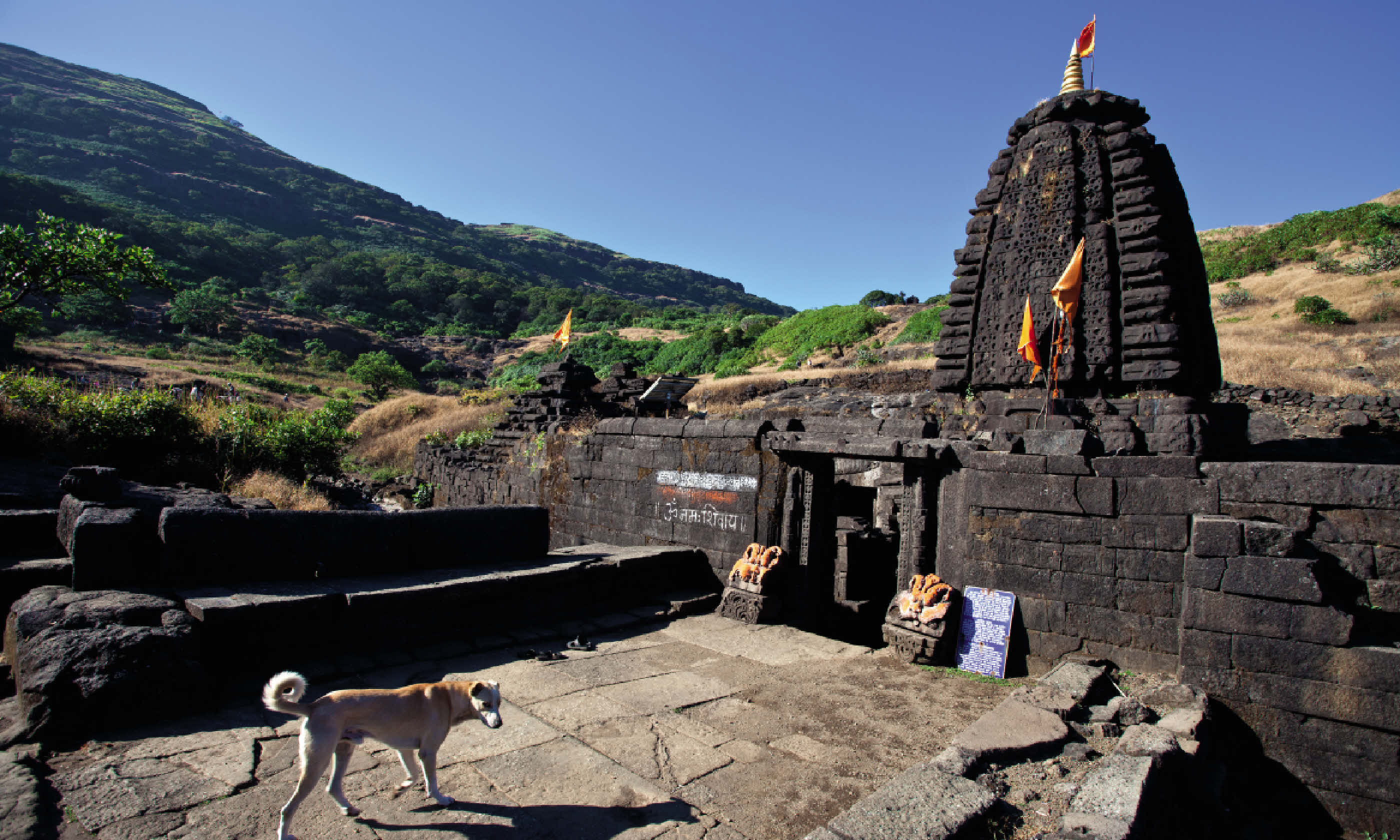 Harishchandragad
Harishchandragad
Luckily, the local lad we’d employed to guide us, Ganesh, had family in the village. Unfazed by the sudden appearance of two foreigners in the middle of a raging tempest, our hosts rustled up a fabulous meal made entirely from produce grown in their own plot. Afterwards, the grandfather proudly showed us the rice mill recently donated to the village by the government.
“How on earth did they get that heavy kit up here?” wondered Pilot. “It must weigh a few tonnes.” The question was answered the following morning after we’d thanked our hosts and followed Ganesh up the old pilgrims’ trail. Travelling downhill in the opposite direction were two young men carrying a spare part for the mill on a long bamboo pole. It had been driven to the top of the mountain on the road, like everything else the machi villagers needed that they couldn’t make themselves, and was now being carried down to the village.
Bhimashankar proved a compelling change of atmosphere after the long ascent. Saffron-clad sadhus lazed outside its 18th-century Shiva temple, reached via a long, stepped walkway lined with stalls of flower offerings and freshly made milk sweets. Pilot and I ordered chai at a teashop, and watched the comings and goings in the shrine before beginning our long descent back to our waiting car and driver.
Rather than race to another uncertain destination as the light faded, we decided to stop for the night in a government hotel at a place called Malshej Ghat, a couple of hours’ north, near one of the major passes through the Sahyadris. Handily situated close to the trailhead of our next day’s route, the hotel looked like it had just come through a war, and so did the staff, sprawled on benches when we arrived (government hotels in India don’t see many customers).
But the place soon sprang to life and the hotel employees took on our trekking mission as their own – quite literally. At 5am the next morning, a group of four – including the manager – had mustered in the pre-dawn darkness, dressed in matching purple Maharashtra Tourism tracksuits, to guide us across the nearby dam and onwards to the landform that would turn out to be the most spectacular of our trip: Harishchandragad, the ‘Mountain of Shiva’s Moon’.
In the wake of the previous night’s storm, the weather had grown cooler. The air was less humid, the light crisper. “This is actually starting to feel like a proper holiday!” grinned Pilot as we emerged from the tree canopy into bright sunshine. “My shirt’s even dry.”
Three hours later, after a lung-stretching haul through forest, we arrived at the hidden plateau at the top of Harishchandragad. Interlaced by streams and smothered in greenery, its focal point is a sloping platform of basalt from whose midst rises an ancient Hindu temple, part hollowed from the bedrock, but with a corn-cob sanctuary tower made from carved masonry placed on top. Caves had been hollowed from the surrounding cliffs, along with bathing tanks of dark-green water for ritual ablutions.
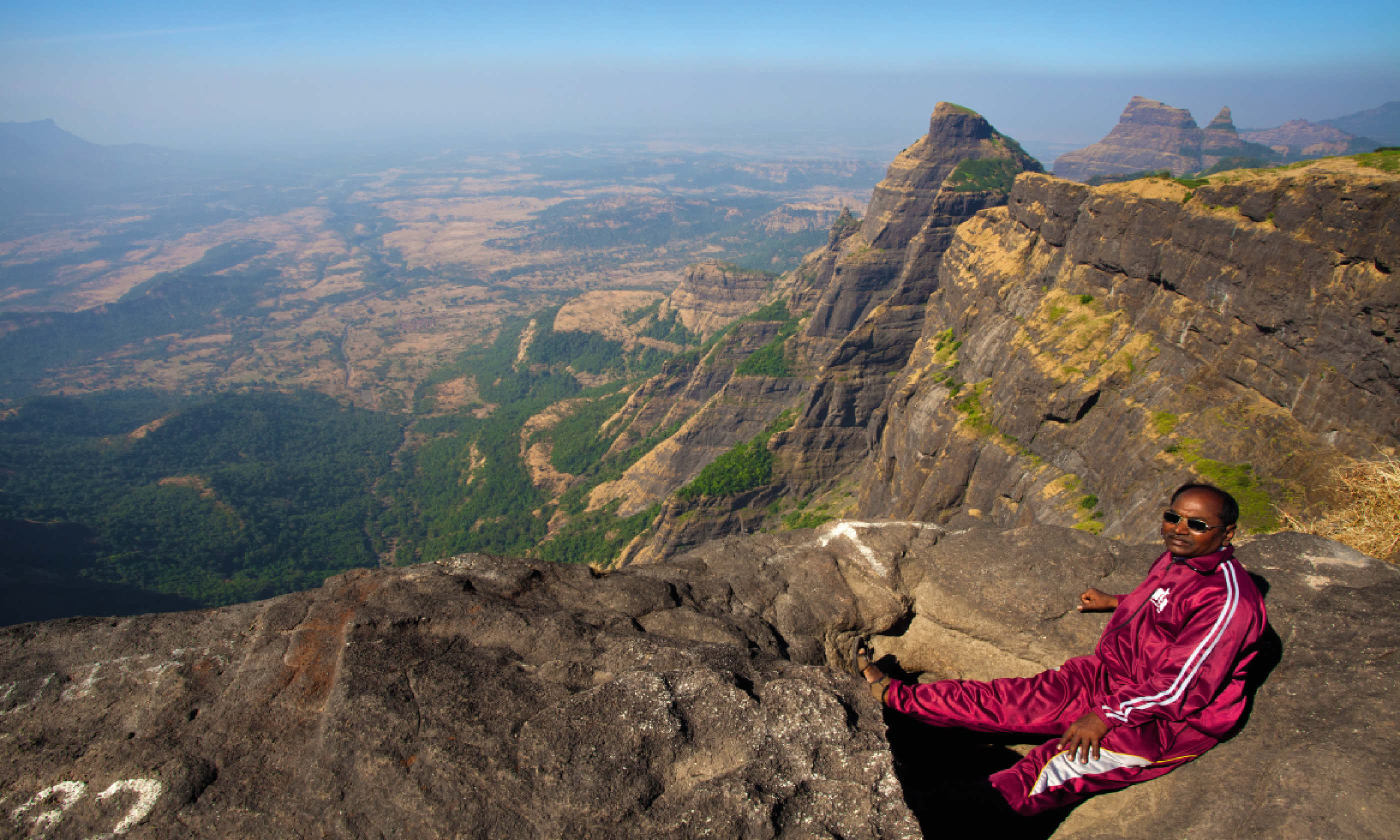 Konkan Kada
Konkan Kada
The real show stopper here though was the Konkan Kada. Another 30 minutes’ walk across the plateau, the rock curled to a sharp lip, then plunged in a huge, over-hanging cliff to a tangle of dry river beds and scrub a kilometre below. Fluted ridges and towers swept up on either side of the escarpment to an amphitheatre of sharp peaks. Vultures spiralled in the thermals below. It was breathtakingly exotic – like stumbling across a tropical version of Scotland’s Cuillin or Torridon, only with a functioning Saxon-era shrine on its summit.
If this were in Europe, the whole area would have been a national park. But there were no waymarked paths or interpretative panels here. Instead of a bothy or refuge, trekkers sleep in the rock-cut cave temples, just like pilgrims have done for thousands of years.
Harishchandragad, however, had saved one final secret for us. Returning to the temple, we came across an intriguingly large cavern hewn from the side of a stream gully. Inside it stood a monolithic Shiva lingam placed in the centre of a square pond, with the remnants of four pillars surrounding the central shrine. “Kedareshwar Cave!” announced our hotel manager, as one of his boys shed his tracksuit and dived in to worship the phallus.
“The pillars are symbols of Hindu yugs.” He went on to explain that the yugs or yugas were stages of human history. After each had passed, a pillar is said to have collapsed. Only one – the fourth and final – remained intact: the column corresponding to Kali Yug, the ‘Age of the Apocalypse’, characterised by “strife, discord and destruction,” Manager Saab intoned, finger raised in the air. This is the era in which Hindu theologians claim we currently exist.
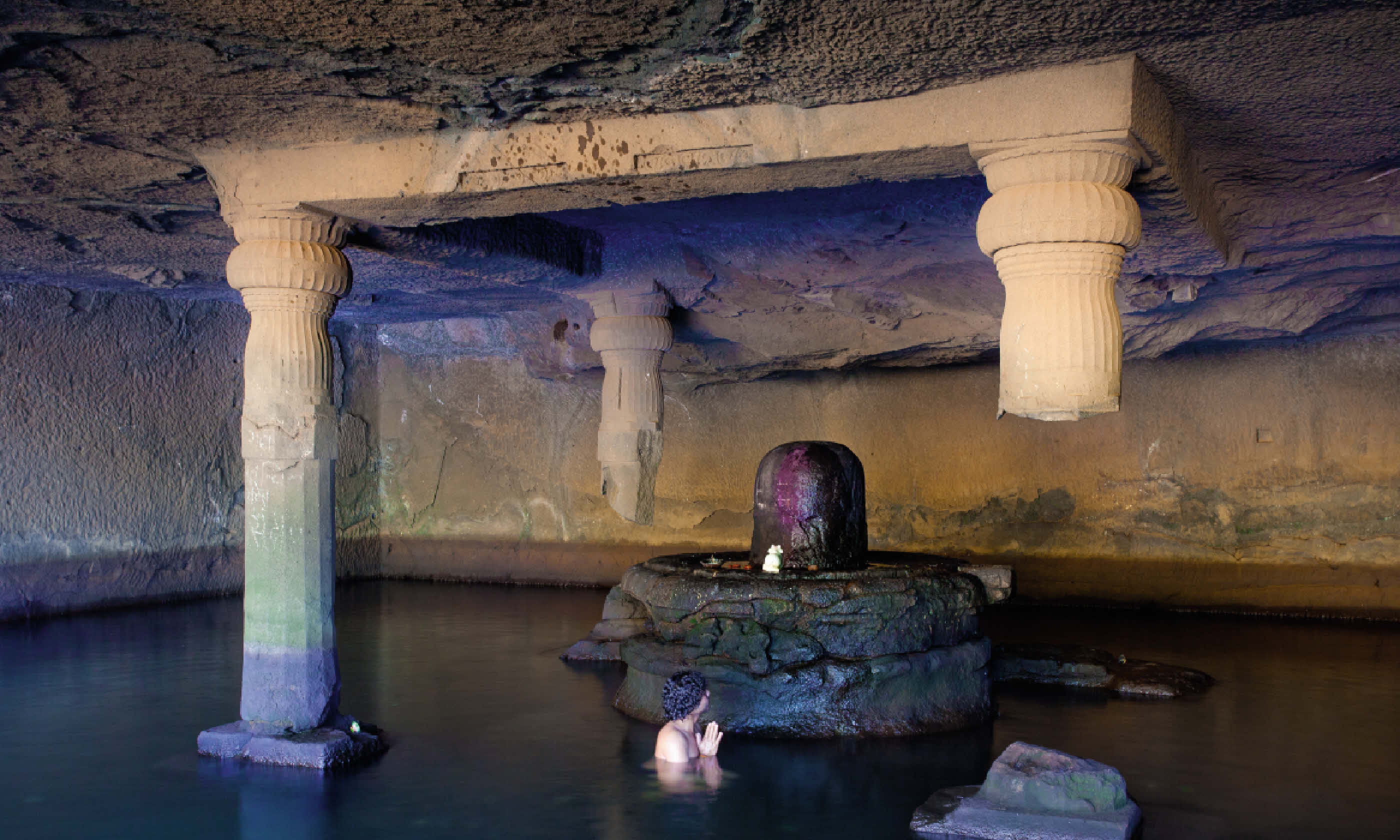 Kedareshwar Cave
Kedareshwar Cave
Standing outside the cave in the warm sunshine, surrounded by leafy forest and high ridges lit by clear morning light, I thought of the tower blocks marching across the plains to the west. I recalled the ads for modern apartments that rose amid the fields we’d driven past, where soon bulldozers would be breaking new ground. It was hard not to feel there might be something in the old prophesy.
Were we in Kali Yug, I wondered? Or at the dawn of a brave new world, as the ads suggest? I guess it depends on which side of India’s economic divide you’re from. Either way, it was a relief to discover that there remain, high in the Sahyadris at least, places in this country that have kept their heads above the rising tide of modern chaos. And judging by the view of endless peaks receding north, plenty more of them remain to be discovered.
The author travelled courtesy of India-specialist TransIndus, which offers nine-day trekking trips in the Sahyadri Mountains on a twin-share basis. For those wishing to travel independently, Mumbai-based Trek Mates India can provide guides and route advice.
All images by David Abrams





